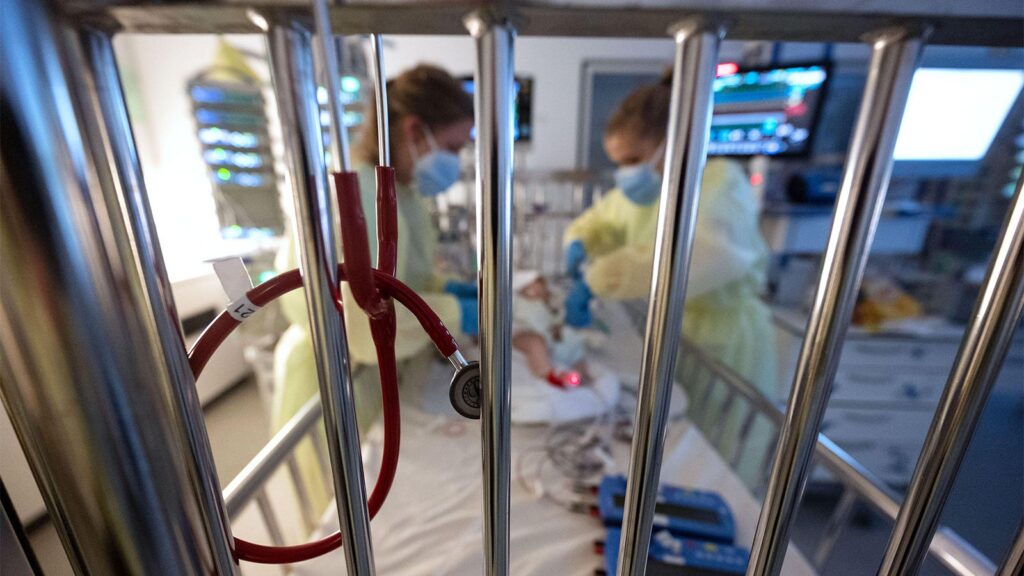A retrospective study revealed that hospital admission rates were far higher for respiratory syncytial virus (RSV) than for the Omicron strain of SARS-CoV-2 or influenza A/B in children presenting at Swedish emergency departments (EDs) from August 2021 to September 2022.
Hospitalization rates were 81.7% for RSV, 31.5% for Omicron, and 27.7% for influenza, Pontus Hedberg, MD, PhD, and researchers from the Karolinska Institutet in Stockholm reported. The results appeared in a JAMA Pediatrics research letter.
“That RSV can be dangerous for both infants and young children is well-known, but the major differences in hospitalization rates observed for RSV compared with both SARS-CoV-2 Omicron and influenza A/B across all age groups were surprising,” Hedberg told MedPage Today by email.
Intensive care unit (ICU) admission rates were low for all three illnesses, but highest for RSV. Of the 2,596 children included in the study, 2.9% with RSV were admitted to the ICU compared with 0.9% for influenza and 0.7% for Omicron. Mortality within 30 days after admission was also low. However, two patients with Omicron and one with RSV died.
The odds of newborns and infants up to 1 year of age with RSV being hospitalized were about 11 times greater than those diagnosed with Omicron (OR 11.29, 95% CI 8.91-14.38). Children ages 2 to 4 years (OR 3.96, 95% CI 2.25-7.01) and youth ages 5 to 17 (OR 5.22, 95% C 2.40-11.81) with RSV also had a far higher odds of hospitalization than those with Omicron.
Asthma, congenital abnormalities, and perinatal conditions were common among the hospitalized children, the study showed.
Richard Malley, MD, an infectious diseases specialist at Boston Children’s Hospital, told MedPage Today that the roughly 80% hospital admission rate for RSV reported in the study seemed high, but that healthcare system practices often vary substantially across countries. “Depending on where you live, going to the ER might be a last resort,” whereas in some areas, people may seek emergency care when primary care options are not accessible, he explained.
The CDC estimates that RSV leads to 58,000-80,000 hospitalizations and 100-300 deaths each year in children under 5 years of age.
The high hospitalization rates in the study were not a surprise to Stanley Spinner, MD, chief medical officer at Texas Children’s Pediatrics in Houston. He told MedPage Today in an email that rates were similar to those seen at his center. In addition to taking steps to prevent RSV in children, “these [study] findings also emphasize that need to continue to educate about the importance of influenza and COVID prevention in the pediatric population,” he said.
Earlier this year, the FDA approved the first maternal RSV vaccine to protect newborns from serious RSV infection. The FDA also approved the monoclonal antibody nirsevimab (Beyfortus) to protect all newborns and infants in or entering their first RSV season, as well as children up to 2 years old who are vulnerable to severe RSV disease. However, in October, the CDC issued a health advisory that nirsevimab was in short supply and could leave many children at risk.
“Ultimately RSV is a major contributor to illness in young children and … the modalities that we have now to prevent RSV could, if applied wisely and broadly, really reduce hospitalizations and RSV morbidity,” Malley said.
The study included 896 children with Omicron, 426 with influenza A/B, and 1,274 with RSV. Most of the children with RSV and Omicron were younger than 2 years of age (77.7% and 72.3%, respectively) while 81% of children with the flu were older. Researchers used multiplex PCR testing to test for SARS-CoV-2, influenza A/B, and RSV all at once, which reduced potential diagnostic bias, Hedberg said. Limitations of the study included its retrospective design and potential underreporting of provided respiratory support. Also, patients with mild disease might have been missed due to underdiagnosis, the authors wrote.
-
Katherine Kahn is a staff writer at MedPage Today, covering the infectious diseases beat. She has been a medical writer for over 15 years.
Disclosures
Support came from the Swedish Research Council and the EuCARE Project, funded by the European Union’s Horizon Europe Research and Innovation Programme.
Hedberg and investigators report no conflicts of interest.
Malley is a consultant with GSK and recipient of consulting fees from GSK and Merck, past research funding from Pfizer and Astellas, and past part-time employment at Affinivax/GSK. He is a member of the scientific advisory board of Corner Therapeutics.
Spinner reports no conflicts of interest.
Primary Source
JAMA Pediatrics
Source Reference: Hedberg P, et al “Outcomes of pediatric SARS-COV2 Omicron infection vs influenza and respiratory syncytial virus infections” JAMA Pediatr 2023; DOI: 10.1001/jamapediatrics.2023.5734.
Please enable JavaScript to view the

